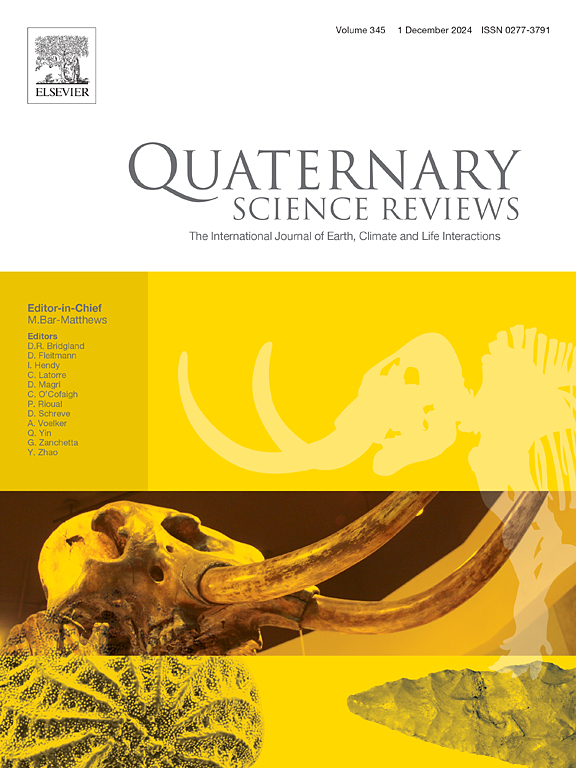The last interglacial and mid-Holocene sea level variability in the northern Indian Ocean and the influence of hydro-isostasy
IF 3.2
1区 地球科学
Q1 GEOGRAPHY, PHYSICAL
引用次数: 0
Abstract
Microtidal coastline around Sri Lanka, situated at the tectonically stable northern Indian Ocean, provides reliable evidence for sea level studies and to understand the hydro isostatic influence on eustatic changes. As the past sea level data are limited in the northern Indian Ocean region and due to the significant discrepancies among the outcomes of previous work, this study used stable, in situ sea level indicators to study the past sea level changes in the region.
Emerged and submerged in situ corals from both north (16 samples) and south (14 samples) were used as marine limiting points (MLP) while beach rocks (06 samples) were used as sea level index points (SLIPs) and lagoon sediment (01 samples) was used as terrestrial limiting point (TLP). Their elevations were measured precisely from the modern mean sea level. Age dating was carried out using Accelerator Mass Spectrometry (AMS), gas bench radiocarbon techniques, and the U-Th method.
Emerged corals at Punkuduthiviu (1.22 m), Iranathivu (0.82 m), and Kachchatheevu (3.55 m), islands located in the Palk Strait, record the evidence for Marine Isotope Stage (MIS) 5e (≊ 128 ka BP relative to 1950 AD) and MIS 5c (≊ 107 ka BP) sea level highstand in the northern Indian Ocean. Corals in northern Islands show that the mid-Holocene highstand (MHH) relative sea level (RSL) was >1.5 m in the north around 6500 cal yrs BP and started decreasing after that. When considering the eroded height and evidence from a wave-cut notch in Kachchatheevu, it can be inferred that the MHH RSL reached about 2 m. In contrast, RSL during MHH in the south reached its maximum (∼1.6 m) about 1000 yrs later (∼5500 cal yrs BP), as evidenced by corals and beach rocks. The post-glacial sea level reached the modern mean tidal level at the southern coast between 6250 and 6500 cal yrs BP and gradually decreased after the MHH. Most MLPs and SLIPs in the south are at lower elevations than in the north. The Holocene sea level variability in the north and south predicted by the ICE-6G_C Glacial Isostatic Adjustment model closely matches field data. The differences in magnitude and timing of MHH between north and south can be explained by contrasting local deflections in continental shelves caused by meltwater loading and transgression velocities, with the broad and gently sloping continental shelf in the north vs. the narrow and steeper shelf in the south.
末次间冰期和全新世中期北印度洋海平面变率及水均衡作用的影响
斯里兰卡周围的微潮海岸线位于构造稳定的北印度洋,为海平面研究和了解水文均衡对涨落变化的影响提供了可靠的证据。由于北印度洋地区过去的海平面数据有限,且以往工作的结果差异较大,因此本研究采用稳定的原位海平面指标来研究该地区过去的海平面变化。以北部(16个样本)和南部(14个样本)的浮出和淹没原位珊瑚作为海洋极限点(MLP),以海滩岩石(06个样本)作为海平面指数点(slip),以泻湖沉积物(01个样本)作为陆地极限点(TLP)。它们的高度是根据现代平均海平面精确测量出来的。使用加速器质谱法(AMS)、气台式放射性碳技术和U-Th法进行年龄测定。位于保克海峡的Punkuduthiviu岛(1.22 m)、Iranathivu岛(0.82 m)和Kachchatheevu岛(3.55 m)上出现的珊瑚记录了北印度洋海洋同位素阶段(MIS) 5e(相对于1950年的 128 ka BP)和MIS 5c (107 ka BP)海平面高点的证据。北部岛屿珊瑚表明,在6500 cal - ybp左右,北部的中全新世高地(MHH)相对海平面(RSL)为>;1.5 m,此后开始下降。考虑到侵蚀高度和kachchtheevu的一个波切缺口的证据,可以推断MHH RSL达到约2 m。相比之下,南部MHH期间的RSL在大约1000年后(~ 5500 cal - yrs BP)达到最大值(~ 1.6 m),珊瑚和海滩岩石证明了这一点。冰后海平面在6250 ~ 6500 cal - ybp之间达到南海岸现代平均潮位,在MHH之后逐渐下降。大多数南部的mlp和slip的海拔都比北部低。ICE-6G_C冰川均衡调整模式预测的南北全新世海平面变化与实测资料吻合较好。南北之间MHH的大小和时间差异可以通过由融水负荷和海侵速度引起的大陆架局部偏转的对比来解释,北方的大陆架宽而平缓,而南方的大陆架窄而陡峭。
本文章由计算机程序翻译,如有差异,请以英文原文为准。
求助全文
约1分钟内获得全文
求助全文
来源期刊

Quaternary Science Reviews
地学-地球科学综合
CiteScore
7.50
自引率
15.00%
发文量
388
审稿时长
3 months
期刊介绍:
Quaternary Science Reviews caters for all aspects of Quaternary science, and includes, for example, geology, geomorphology, geography, archaeology, soil science, palaeobotany, palaeontology, palaeoclimatology and the full range of applicable dating methods. The dividing line between what constitutes the review paper and one which contains new original data is not easy to establish, so QSR also publishes papers with new data especially if these perform a review function. All the Quaternary sciences are changing rapidly and subject to re-evaluation as the pace of discovery quickens; thus the diverse but comprehensive role of Quaternary Science Reviews keeps readers abreast of the wider issues relating to new developments in the field.
 求助内容:
求助内容: 应助结果提醒方式:
应助结果提醒方式:


